Questões de Língua Inglesa da Centro de Produção da Universidade Federal do Rio de Janeiro (CEPERJ)
Lista completa de Questões de Língua Inglesa da Centro de Produção da Universidade Federal do Rio de Janeiro (CEPERJ) para resolução totalmente grátis. Selecione os assuntos no filtro de questões e comece a resolver exercícios.
Língua Inglesa - Gramática - Centro de Produção da Universidade Federal do Rio de Janeiro (CEPERJ) - 2014
Questions 21 to 28 address both the teaching of English as a foreign language and the Parâmetros Curriculares Nacionais PCN. Read them and mark the right alternative: English Language Teaching practice has incorporated the following principle as part of its most recent procedures (Harmer, 1998: 32):
- A. words and phrases are better blocks than grammatical structures to describe language
- B. the emphasis of a language lesson should always be on tasks
- C. students should learn about language as part of learning a language
- D. Activate, Engage and Study (in this order) are the building blocks of a successful language lesson
- E. students must study language evidence to discover grammatical rules themselves
Língua Inglesa - Gramática - Centro de Produção da Universidade Federal do Rio de Janeiro (CEPERJ) - 2014
Students, like the rest of us, need to be able to do a number of things with a reading text. (Harmer, 1998: 69). One of these ´things´ is to skim the text, or rather, to:
- A. predict information before they read the text properly
- B. match the task they are performing to the topic of the text
- C. cast their eyes over the text´s surface to get a general idea
- D. read slowly and derive pleasure from what they are reading
- E. read the text for specific bits of information they are looking for
Língua Inglesa - Gramática - Centro de Produção da Universidade Federal do Rio de Janeiro (CEPERJ) - 2014
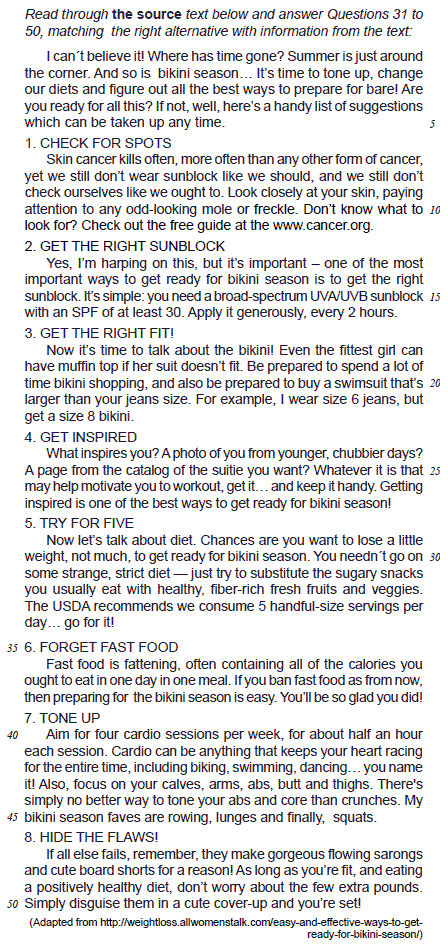 The English verb phrase can be marked for tense and aspect. The use of the perfect tense in Where has time gone? (line 1), establishes the following:
The English verb phrase can be marked for tense and aspect. The use of the perfect tense in Where has time gone? (line 1), establishes the following:
- A. a present habit linked to an indefi nite past
- B. a state of affairs before the present moment
- C. an indefi nite state in a period prior to the present
- D. an event with current relevance to the present time
- E. a past situation unrelated to the present point in time
Língua Inglesa - Gramática - Centro de Produção da Universidade Federal do Rio de Janeiro (CEPERJ) - 2014
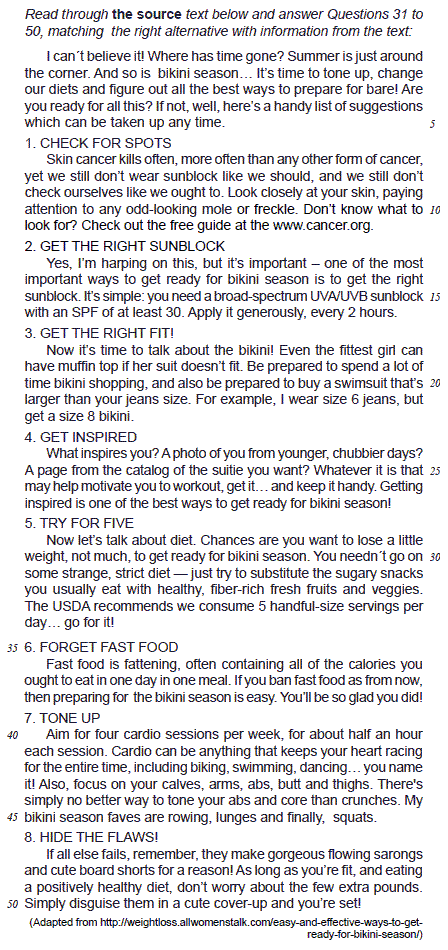 A text is cohesive if, as a whole, its sentences are linked and make sense. An example of cohesion in the source text is If not (line 4), which is characterized by:
A text is cohesive if, as a whole, its sentences are linked and make sense. An example of cohesion in the source text is If not (line 4), which is characterized by:
- A. anaphora
- B. cataphora
- C. exophora
- D. ellipsis
- E. substitution
Língua Inglesa - Gramática - Centro de Produção da Universidade Federal do Rio de Janeiro (CEPERJ) - 2014
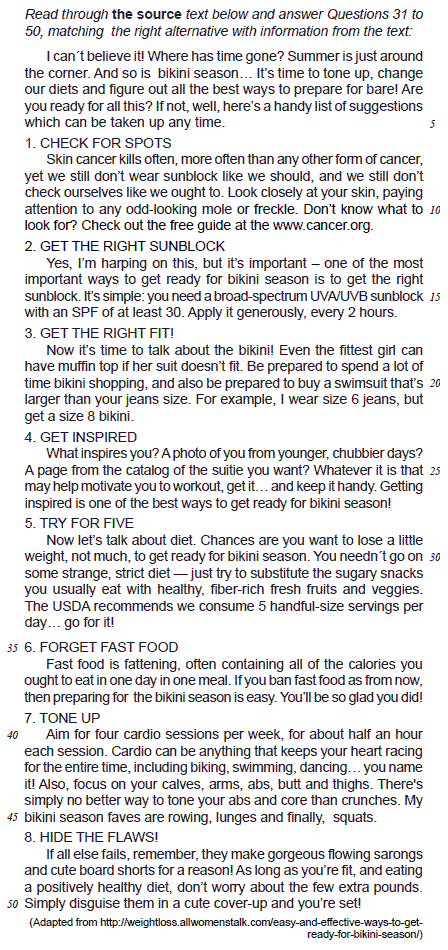 The connective in Skin cancer kills more young women than any other form of cancer, yet we still dont wear sunblock (line 7-8) links the clauses in terms:
The connective in Skin cancer kills more young women than any other form of cancer, yet we still dont wear sunblock (line 7-8) links the clauses in terms:
- A. time
- B. addition
- C. concession
- D. contrast
- E. condition
Língua Inglesa - Gramática - Centro de Produção da Universidade Federal do Rio de Janeiro (CEPERJ) - 2014
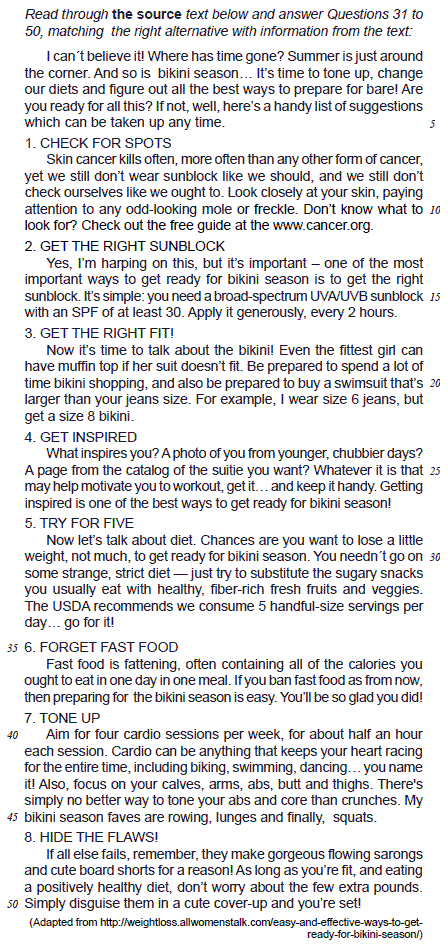 Phrasal verbs are the combination of a verb plus a preposition or adverb, resulting in a new meaning. Prepositional verbs are simply verbs which require prepositions. The only combination below which contains a prepositional verb is:
Phrasal verbs are the combination of a verb plus a preposition or adverb, resulting in a new meaning. Prepositional verbs are simply verbs which require prepositions. The only combination below which contains a prepositional verb is:
- A. tone up (line 2)
- B. Dont know what to look for (line 10-11)
- C. Also, focus on your calves (line 43)
- D. Yes, I´m harping on this (line 13)
- E. a handy list of suggestions which can be taken up (line 4-5)
Língua Inglesa - Gramática - Centro de Produção da Universidade Federal do Rio de Janeiro (CEPERJ) - 2014
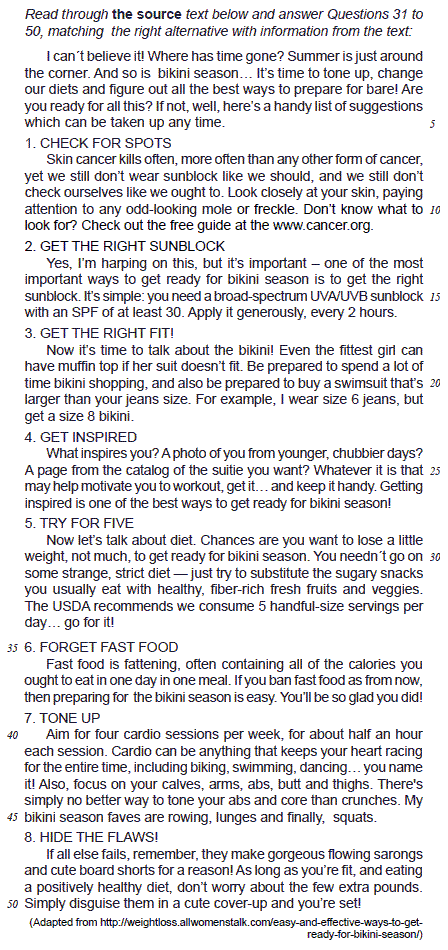 The ING suffix particle may be added to a word in order to turn it into a noun, and adjective or a verb. The alternative which shows the same use of the ING suffix as in Getting inspired is one of the best ways to get ready for bikini season! (line 26-27) is:
The ING suffix particle may be added to a word in order to turn it into a noun, and adjective or a verb. The alternative which shows the same use of the ING suffix as in Getting inspired is one of the best ways to get ready for bikini season! (line 26-27) is:
- A. Look closely at your skin, paying attention to any... (line 9)
- B. Fast food is fattening, often containing all of the calories you ought to eat (line 36-37)
- C. If you ban fast food as from now, then preparing for the bikini season is easy (line 37-38)
- D. As long as youre fit, and eating a positively (line 48-49)
- E. Cardio can be anything that keeps your heart racing (line 41)
Língua Inglesa - Gramática - Centro de Produção da Universidade Federal do Rio de Janeiro (CEPERJ) - 2014
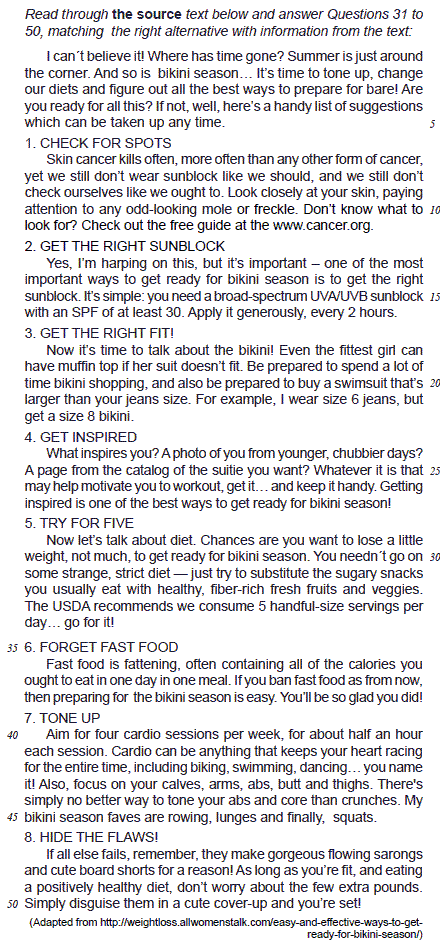 The passive form of:
they make gorgeous flowing sarongs and cute board shorts for a reason! (line 47-48) is:
The passive form of:
they make gorgeous flowing sarongs and cute board shorts for a reason! (line 47-48) is:
- A. there are gorgeous flowing sarongs and cute board shorts being made for a reason!
- B. gorgeous flowing sarongs and cute board shorts are made for a reason!
- C. gorgeous flowing sarongs and cute board can be made shorts for a reason!
- D. they have made gorgeous flowing sarongs and cute board shorts for a reason!
- E. gorgeous flowing sarongs and cute board shorts have been made for a reason!
Língua Inglesa - Gramática - Centro de Produção da Universidade Federal do Rio de Janeiro (CEPERJ) - 2014
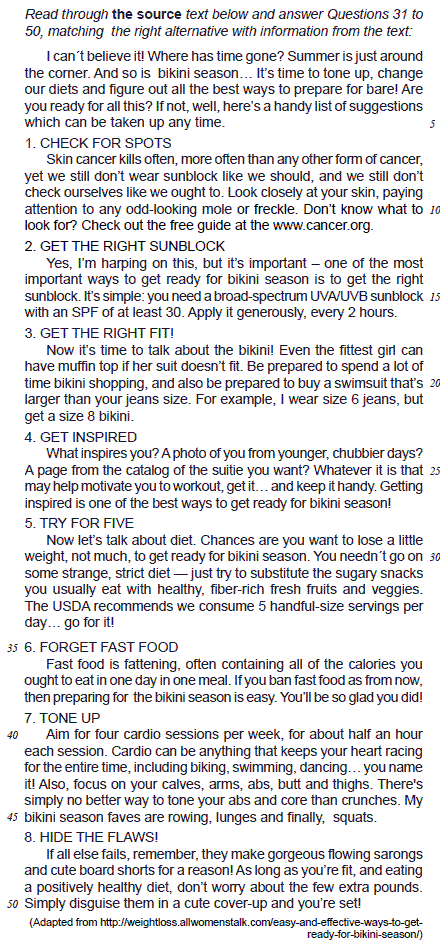 A semi-modal verb in English is a special, non-typical type of verb which behaves like a lexical verb but also expresses modality (Carter and McCarthy, 2006: 395) The modal meaning expressed by the semi-modal in the clause You needn´t go on some strange, strict diet
is one of lack of:
A semi-modal verb in English is a special, non-typical type of verb which behaves like a lexical verb but also expresses modality (Carter and McCarthy, 2006: 395) The modal meaning expressed by the semi-modal in the clause You needn´t go on some strange, strict diet
is one of lack of:
- A. necessity
- B. permission
- C. volition
- D. obligation
- E. ability
Língua Inglesa - Gramática - Centro de Produção da Universidade Federal do Rio de Janeiro (CEPERJ) - 2014
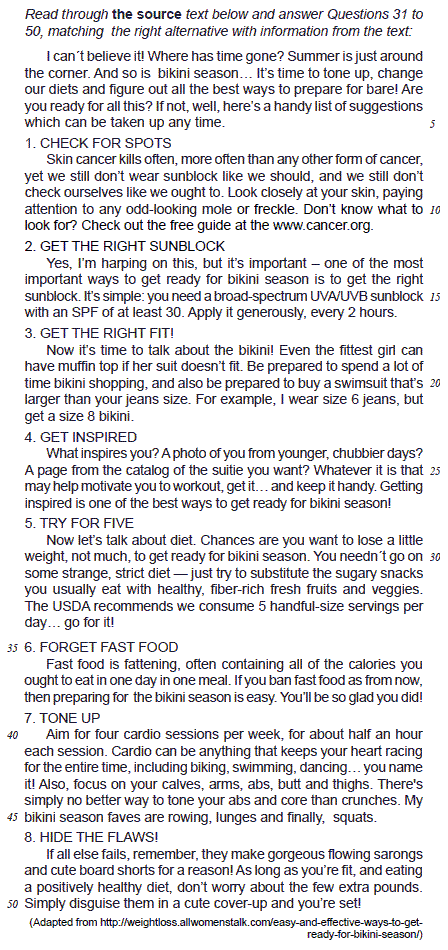 Adjectives describe the features of people and things denoted by nouns or pronouns. On the whole, they cannot be identifi ed by their form, but most typically by their functions in a sentence (Carter and McCarthy, 2006: 236). According to the text, the only sequence that contains words which function as adjectives is :
Adjectives describe the features of people and things denoted by nouns or pronouns. On the whole, they cannot be identifi ed by their form, but most typically by their functions in a sentence (Carter and McCarthy, 2006: 236). According to the text, the only sequence that contains words which function as adjectives is :
- A. bikini, ready, handy (paragraph 1)
- B. sunblock, odd-looking, free (paragraph 2)
- C. important, right, SPF (paragraph 3)
- D. fittest, larger, suit (paragraph 4)
- E. photo, younger, chubbier (paragraph 5)


